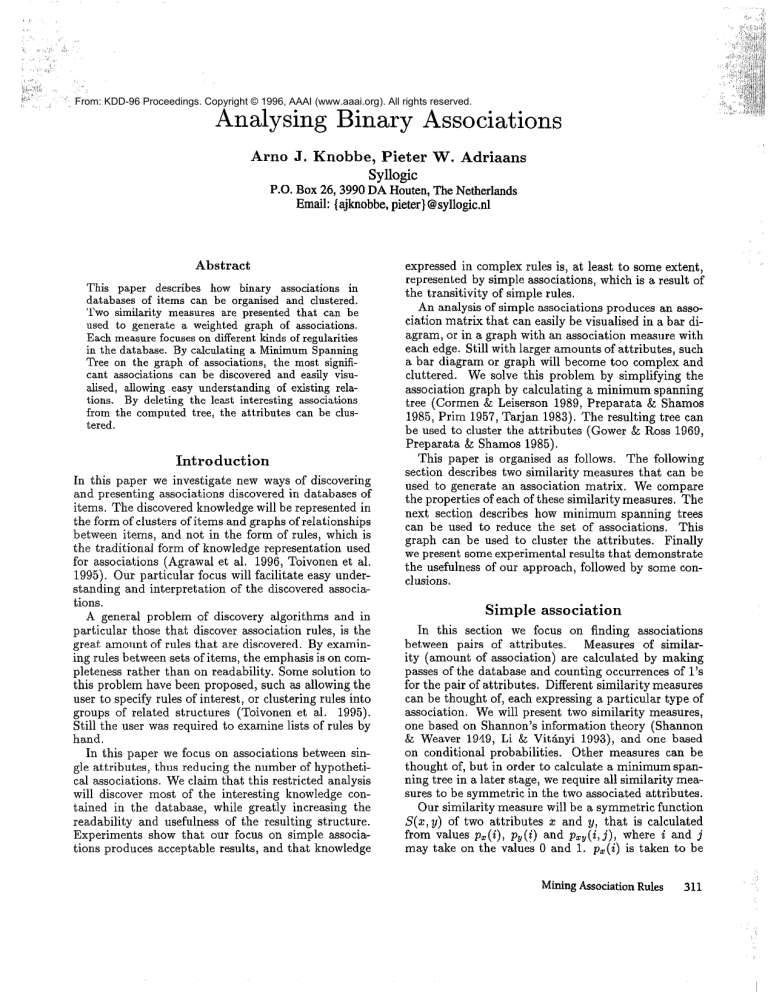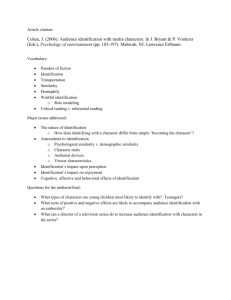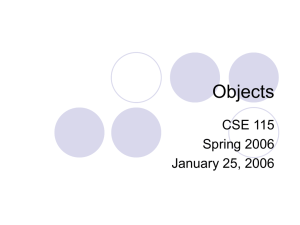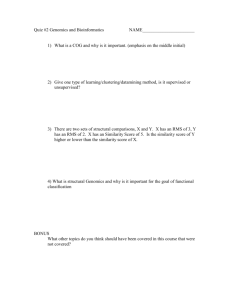
From: KDD-96 Proceedings. Copyright © 1996, AAAI (www.aaai.org). All rights reserved.
Analysing Binary Associations
Arno
J. Knobbe,
Pieter
Syllogic
W. Adriaans
P.O. Box 26,399O DA Houten, The Netherlands
Email: { ajknobbe,pieter} @syllogic.nl
Abstract
This paper describes how binary associations in
databases of items can be organised and clustered.
Two similarity measures are presented that can be
used to generate a weighted graph of associations.
Each measure focuses on different kinds of regularities
in the database. By calculating a Minimum Spanning
Tree on the graph of associations, the most significant associations can be discovered and easily visualised, allowing easy understanding of existing relations. By deleting the least interesting associations
from the computed tree, the attributes can be clustered.
Introduction
In this paper we investigate new ways of discovering
and presenting associations discovered in databases of
items. The discovered knowledge will be represented in
the form of clusters of items and graphs of relationships
between items, and not in the form of rules, which is
the traditional form of knowledge representation used
for associations (Agrawal et al. 1996, Toivonen et al.
1995). Our particular focus will facilitate easy understanding and interpretation of the discovered associations.
A general problem of discovery algorithms and in
particular those that discover association rules, is the
great amount of rules that are discovered. By examining rules between sets of items, the emphasis is on completeness rather than on readability. Some solution to
this problem have been proposed, such as allowing the
user to specify rules of interest, or clustering rules into
groups of related structures (Toivonen et al. 1995).
Still the user was required to examine lists of rules by
hand.
In this paper we focus on associations between single attributes, thus reducing the number of hypothetical associations. We claim that this restricted analysis
will discover most of the interesting knowledge contained in the database, while greatly increasing the
readability and usefulness of the resulting structure.
Experiments show that our focus on simple associations produces acceptable results, and that knowledge
expressed in complex rules is, at least to some extent,
represented by simple associations, which is a result of
the transitivity of simple rules.
An analysis of simple associations produces an association matrix that can easily be visualised in a bar diagram, or in a graph with an association measure with
each edge. Still with larger amounts of attributes, such
a bar diagram or graph will become too complex and
cluttered. We solve this problem by simplifying the
association graph by calculating a minimum spanning
tree (Cormen & Leiserson 1989, Preparata & Shamos
1985, Prim 1957, Tarjan 1983). The resulting tree can
be used to cluster the attributes (Gower & Ross 1969,
Preparata & Shamos 1985).
This paper is organised as follows. The following
section describes two similarity measures that can be
used to generate an association matrix. We compare
the properties of each of these similarity measures. The
next section describes how minimum spanning trees
can be used to reduce the set of associations. This
graph can be used to cluster the attributes.
Finally
we present some experimental results that demonstrate
the usefulness of our approach, followed by some conclusions.
Simple
association
In this section we focus on finding associations
between pairs of attributes.
Measures of similarity (amount of association) are calculated by making
passes of the database and counting occurrences of l’s
for the pair of attributes. Different similarity measures
can be thought of, each expressing a particular type of
association. We will present two similarity measures,
one based on Shannon’s information theory (Shannon
& Weaver 1949, Li & Vitdnyi 1993), and one based
on conditional probabilities.
Other measures can be
thought of, but in order to calculate a minimumspanning tree in a later stage, we require all similarity measures to be symmetric in the two associated attributes.
Our similarity measure will be a symmetric function
S(z, y) of two attributes x and y, that is calculated
from values pz(i), pY(t) and pzy(irj), where i and j
may take on the values 0 and 1. pm(i) is taken to be
Mining Association Rules
311
nsurance
sa
Figure 1: Association matrix for the bank database using I(z, y), and P(z, y).
an estimation of the probability of attribute x being i,
and is defined as the number of times 2 has the value i,
divided by the total number of records in the database.
Similarly for py (i) and p,,(i, j).
The first similarity measure is based on information
theory, and is commonly known as mutual information.
It is defined as
Clearly I(z, y) is symmetric.
For a rationale behind this definition see (Li & Vit&nyi 1993). The mutual information between two attributes describes the
amount of information that one attributes gives about
the other. The definition of mutual information describes the amount of information but does not determine the type of relation between two attributes. Two
attributes that always have reversed values will be similar according to this measure.
The second measure considered in this paper is based
on probability theory, It is defined as
P(x, Y) =
P&
1)
PE(l)P, (1)
This measure is closely related to the definition of confidence for association rules (Agrawal et al. 1996). It
can be thought of as the ratio between the estimation
of the conditional probability w,
and the estimation of the apriori probability p,(l). The conditional
probability coincides with the confidence for an association rule 2 -+ y.
example 1. Fig 1 shows the association matrix for a
database of customers of a bank using the two different similarity measures. The database contains 8844
312
Technology Spotlight
records having seven attributes that describe the seven
different classes of products provided by the bank. Fig
1 on the left shows the results of using mutual information as a similarity measure. High bars correspond to
pairs of similar attributes. Dark bars are positive relations, light bars are negative. Clearly there is a strong
positive relation between payments and insurances, insurances and mortgages, etc., indicated by several dark
bars. Apparently there is a negative relation between
payments and equities.
Fig 1 on the right shows the results of the similarity
measure based on conditional probabilities. The most
significant relations are now between equities and deposits, and between insurances and mortgages.
The two measures are biased towards different types
of association. 1(x, y) will reveal both positive and
negative relations, but has a bias towards attributes
of which ~~(1) are close to p,(O). Two attributes that
are rarely 1 (or 0) but always at the same time will
not be recognised as a significant relation. P(z, y) will
reveal relations between attributes that are rarely 1
(see for example equities and deposits) but will only
show positive relations. Thus different measures can
be used depending on the type of association that is
searched for.
Clustering
The association matrix calculated in the previous section can be used to report all association above a certain level. However the end-user would still be required to examine lists of (simple) rules. In this section we consider the graph defined by the association
matrix and show how this fully connected graph can
be simplified by calculating a minimum spanning tree
(Cormen & Leiserson 1989, Preparata & Shamos 1985,
Mortgage
0.959
Savink3
J;ce
I
Insurance
7.47
7.89 \
Depos;ypLy
PA\
I
Loans
..
4.28
Equities
Loans
Payment
Deposits
Figure 2: Minimum spanning trees for the bank database using 1(x, y), and P(x, y).
Prim 1957, Tarjan 1983). This minimumspanning tree
(MST) can then be used to cluster attributes (Cormen
& Leiserson 1989).
We define the association graph of a database of
items as a fully connect undirected graph G = (V, E),
where V is the set of vertices each of which represents an attribute and E the set of edges connecting
the attributes. For each edge (8, y) we have a value
d(z, y) = -S(z:, y) specifying the distance between two
attributes, which we define as the negation of the similarity. Note that d(z, y) may be negative.
An acyclic subset T 2 E is a MST if it connects all
vertices, and minimises the sum
Two greedy algorithms for computing MSTs,
Kruskal’s and Prim’s algorithm, are described in (Cormen & Leiserson 1989). They both work by growing
a tree from a single vertex, adding one edge at a time.
They differ in what edge is added to the subset of edges
that form the tree at each iteration. Kruskal’s algorithm maintains a forest, starting with every vertex
being a single tree. At each step two trees are joined
by choosing an edge with a minimal weight. Prim’s
algorithm works by adding edges to a single tree that
is a subset of the final MST.
Kruskai’s algorithm can be implemented to run in
WlEl k I VI>* p rim’s algorithm runs in O(lEl Ig [VI)
using ordinary heaps or CJ(IEI + (VI lg [VI) using Fibonacci heaps for finding new edges efficiently. Because (E( = O(lV(2) P rim’s algorithm will run in
O(1V12 + IV/1IglVl) = O(lV12) which is clearly optimal
because an association matrix of complexity S(lV12)
needs to be fully examined, if no assumptions on the
type of similarity measure are made.
example 2. Fig 2 shows the effect of calculating the
MST for the two matrices from example 1. It conveys
the most interesting associations in a readable fashion. Again we see the properties of the two similarity
measures in the organisation of the two trees. Payment and equities are connected in the graph on the
left because there is a reverse relation between the two
attributes. The relation between equities and deposits
is only revealed in the right graph because the associated similarity measure does focus on such infrequent,
associations.
Computation of a MST can be thought of as reducing the complexity of the graph while respecting the
connectivity of the graph. We can’push the balance
between these two goals towards reduction of complexity by repeatedly removing those associations that are
least important in the MST. Every removal will cause
a subtree to be split into two separate groups. We will
thus end up with clusters of attributes that have high
internal similarity. Because every association between
attributes of two different clusters are less then the
single connection that was cut (see (Cormen & Leiserson 1989)), dissimilarity between seperate clusters is
guaranteed.
Experiments
We analyse an enrollment database of courses in computer science, using the approach presented in the previous sections. The database consists of.2836 records
each describing the courses taken by a single student.
On average between six and seven courses were taken
by each student, from a total of 127 courses.
An MST containing the 127 courses is computed using the mutual information-based measure 1(x, y). Fig
3 show some details of the MST. Clearly the structure of the subtrees seems to coincide with our common knowledge of relations between the subjects that
are covered in each course. Fig 3 seems to deal with
courses about databases and user interfaces. Apparently the link between these two subjects is made by
Mining Association Rules
313
/
‘,
R e s e a r c h sem. o n
User Interfaces
S o ftware E n g i n e e r i n g
” :(
‘/”
R e s e a r c h of
User Interfac
User Interfaces
Information Systems
Information Systems
C o m p u ter S u p p o r t e d
Cooperative W o r k
Logic Databases
,‘.‘d!,
Figure 3: Part of Finnish courses.
‘User Interfaces of Information Systems’, a course that
c o m b i n e s subjects from the two areas.
Clustering o n this M S T h a s the effect of putting outlyers in clusters of a single course, such as ‘S e m . o n
Scientific Visualisation’, ‘C o m p u tational~G e o m e try’or
‘Principles of P r o g r a m m i n g L a n g u a g e s ( A d a ) ‘. T h e s e
courses a p p e a r to b e taken independently of other
available courses. Continuing the clustering process
will then split the r e m a i n i n g tree into particular subgroups, such as the a r e a of databases, system p r o g r a m ming, etc. A g o o d criterion for continuing the clustering process s e e m s to b e h a r d to define.
Conclusion
This p a p e r describes h o w information contained in binary associations c a n b e exploited to the fullest. O u r
a p p r o a c h analyses a subset of the possible associations
considered in traditional association rule discovery algorithms, but from the experiments it is clear that it
d o e s not suffer from this restriction, a n d e v e n allows
m o r e effective ways of presenting the discovered knowledge.
T w o similarity m e a s u r e s for attributes h a v e b e e n
presented, e a c h e m p h a s i s i n g particular characteristics
N e w similarity
of associations b e t w e e n attributes.
m e a s u r e s should b e e x a m i n e d with the a i m of c o m bining useful properties from the presented measures.
B y computing the m i n i m u m s p a n n i n g tree of the association graph, w e focus o n the particular subset of
large associations that is sufficient to include all attributes. W e intend to e x a m i n e the effect of reducing
or extending this set of associations, especially in the
context of clustering.
314
T e c h n o l o g yS p o tlight
Acknowledgement
W e thank H a n n u T o i v o n e n for providing the student
enrollment d a t a b a s e (in Finnish).
R e fe r e n c e s
Agrawal, R., Mannila, H., Srikant, R., Toivonen,
H., V e r k a m o , A . 1 9 9 6 . Fast Discovery of Association
R&es. in A d v a n c e in K n o w l e d g e Discovery a n d Data
Mining.
C o r m e n , T.H., Leiserson, C.ti., Rivest, R.L. 1 9 8 9 . Introduction to AZgorithms. M IT Press/McGraw-Hill.
G o w e r , J.C., Ross, G .J.S . 1 9 6 9 . M i n i m u m s p a n n i n g
trees a n d single linkage cluster analysis. Appl. S tat.
18(l), 54-64.
Li, M ., Vit&yi, P .M .B . 1 9 9 3 . A n Introduction to Kolm o g o r o v Complexity a n d its Applications. SpringerVerlag.
Preparata, F.P., S h a m o s , M .I. 1 9 8 5 . C o m p u tational
G e o m e try: A n Introduction. Springer-Verlag.
Prim, R.C. 1 9 5 7 . Shortest connection networks a n d
s o m e generalizations. Bell System Technical Journal,
36:1389-1401.
S h a n n o n , C.E., Weaver, W . 1 9 4 9 . T h e M a thematical Theory of Communication. University of Illinois
Press, Urbana, IL.
Tarjan, R.E. 1 9 8 3 . Data structures a n d Network Algorithms. Society for Industrial a n d A p p l i e d M a them a tics.
Toivonen, H., Klemettinen, M ., Ronkainen, P .,
H % tG n e n ,K ., Mannila, H. 1 9 9 5 . P r u n i n g a n d G r o u p ing Discovered Association Rules. E C M L - 9 5 works h o p o n S tatistics, M a c h i n e L e a r n i n g a n d K n o w l e d g e
Discovery in Databases.



